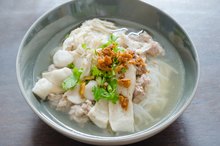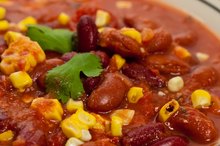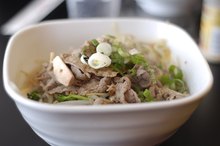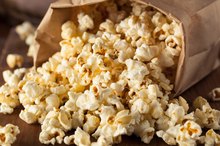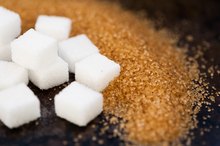What does fact checked mean?
At Healthfully, we strive to deliver objective content that is accurate and up-to-date. Our team periodically reviews articles in order to ensure content quality. The sources cited below consist of evidence from peer-reviewed journals, prominent medical organizations, academic associations, and government data.
The information contained on this site is for informational purposes only, and should not be used as a substitute for the advice of a professional health care provider. Please check with the appropriate physician regarding health questions and concerns. Although we strive to deliver accurate and up-to-date information, no guarantee to that effect is made.
Nutrition Facts for Hidden Valley Ranch Dressing
Ranch dressing is the most popular salad dressing in the United States, and Hidden Valley Ranch is the original, according to the HV Food Products Co 2. The dressing -- a mixture of buttermilk, herbs and spices -- is named for the California ranch where it was created. Today the company makes several variations, but the original remains most popular.
Tips
Hidden Valley Ranch Dressing has 292 Calories and 12.31 g of Protein per 100 gram serving according to the nutrition facts provided by the USDA Food Composition Database.
Serving Size
The stated serving size for Hidden Valley Ranch dressing is 2 tablespoons 2. The salad dressing is sold in various sized bottles, so the amount of servings in a bottle depends on what size you buy. Keep the serving size in mind when dressing your salad and considering its nutritional value. Many people eat food portions that are much larger than the stated serving size, and this has a drastic effect on your daily dietary intake, the U.S. Department of Agriculture reports.
- The stated serving size for Hidden Valley Ranch dressing is 2 tablespoons 2.
- The salad dressing is sold in various sized bottles, so the amount of servings in a bottle depends on what size you buy.
Calories
Nutritional Information on Publix Sushi
Learn More
Each 2 tablespoon serving of Hidden Valley Ranch dressing contains 140 calories, and the vast majority of them -- 130 -- are calories from fat 2. If you eat a 2,000-calories-per-day diet, each serving of the dressing amounts to 6.5 percent of your daily intake total. A calorie is a unit of measurement for the amount of energy a food contains. Foods higher in calories contain more energy, the Food and Drug Administration reports 1. However, it is important to balance caloric intake with intake of essential dietary components as well as vitamins and minerals.
Fat
Each serving of Hidden Valley Ranch dressing contains 14 grams of total fat, which is equal to 22 percent of the recommended maximum intake for fat if you eat 2,000 calories a day 2. The fat in the dressing includes 2.5 grams of saturated fat -- equivalent to 12 percent of the maximum intake recommendation. The dressing also contains 10 milligrams of cholesterol, or 3 percent of the recommended intake.
Sodium
Nutritional Value of Fritos
Learn More
Your body requires sodium for basic cellular function, but too much can increase your risk for serious conditions such as high blood pressure. Because of the risks, the USDA recommends limiting your intake to no more than 2,300 milligrams daily. Each serving of Hidden Valley Ranch dressing contains 260 milligrams of sodium, which is equal to 11 percent of the maximum intake 2.
Carbohydrates
Hidden Valley Ranch salad dressing contains only a small amount of carbohydrates -- 2 grams per serving 2. The total carbs is equivalent to 1 percent of the daily intake recommendation. The carbohydrates in the dressing includes 1 gram of sugar.
- Hidden Valley Ranch salad dressing contains only a small amount of carbohydrates -- 2 grams per serving 2.
- The carbohydrates in the dressing includes 1 gram of sugar.
Protein
Most foods contain at least a small amount of protein, and Hidden Valley Ranch dressing is among these 2. Each 2-tablespoon serving contains 1 gram of protein. Because protein is not deficient in the typical American diet, the federal government has not set firm intake recommendations, the FDA reports.
- Most foods contain at least a small amount of protein, and Hidden Valley Ranch dressing is among these 2.
- Because protein is not deficient in the typical American diet, the federal government has not set firm intake recommendations, the FDA reports.
Related Articles
References
- Food and Drug Administration: How to Understand and Use the Nutrition Facts Label
- Hidden Valley: Original Ranch Dressing
- Ranch, French, Italian: What’s your favorite salad dressing? The Association for Dressings and Sauces.
- Salad dressing, ranch dressing, regular. USDA FoodData Central. Updated 4/1/2020
- Vitamin K. Fact Sheet for Professionals. National Institutes of Health Office of Dietary Supplements. Updated June 3, 2020
- Fat-Soluble Vitamin. National Cancer Institute.
- Mayonnaise, regular. USDA FoodData Central. Updated April 1, 2020
- Fusaro M, Mereu MC, Aghi A, Iervasi G, Gallieni M. Vitamin K and bone. Clin Cases Miner Bone Metab. 2017;14(2):200–206. doi:10.11138/ccmbm/2017.14.1.200
- Stewart, Hayden and Hyman, Jeffrey. Americans Still Can Meet Fruit and Vegetable Dietary Guidelines for $2.10-$2.60 per Day. USDA Economic Research Service. June 03, 2019
- Bayan L, Koulivand PH, Gorji A. Garlic: a review of potential therapeutic effects. Avicenna J Phytomed. 2014;4(1):1-14.
- Jana S, Shekhawat GS. Anethum graveolens: An Indian traditional medicinal herb and spice. Pharmacogn Rev. 2010;4(8):179-184. doi:10.4103/0973-7847.70915
- Nicastro HL, Ross SA, Milner JA. Garlic and onions: their cancer prevention properties. Cancer Prev Res (Phila). 2015;8(3):181-189. doi:10.1158/1940-6207.CAPR-14-0172
- Milk & Dairy Allergy. American College of Allergy, Asthma, and Immunology. Updated 3/21/2019.
- How much sodium should I eat per day? American Heart Association. May 23, 2018
- Milk Allergy Vs. Lactose Intolerance. Food Allergy Research and Education.
Writer Bio
Anna Aronson began working as a journalist in 2000 and spent six years at suburban Chicago newspapers before pursuing freelance work. She enjoys writing about health care topics, in particular obstetrics, pediatrics and nutrition. She received a Bachelor of Arts in journalism from Eastern Illinois University and is now studying for a Master of Science in medicine degree to become a physician's assistant.


